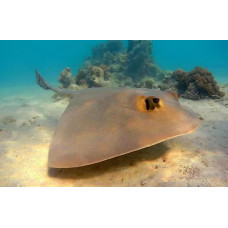Latin name
Pastinachus sephen
Other name
Pastinachus sephen
Identification
The thick pectoral fins of these rays fuse with the head to form a rhombic flattened disc, 1.1-1.3 times as wide as long, with the edges of the fins ("wings") rounded. The front edge is almost straight, the snout blunt and rounded. Behind the small, widely spaced eyes are spatulae. On the ventral surface of the disc are 5 pairs of gill slits, mouth and nostrils. A flap of skin with a fringed lower margin runs between the nostrils.
The mouth of the cowtail ray is small and there are 5 protuberances at the bottom of the mouth. There are 20 rows of teeth on each jaw. The teeth are hexagonal and end in a point.
The tail is whip-shaped and tapers towards the tip. On the dorsal surface, next to a fairly thick base of the caudal peduncle and well behind the pelvic fins, is a spine connected by a canal to a poisonous gland. Behind the spike on the caudal peduncle there is a ventral fold of skin that does not reach the tip and is 2-3 times the height of the tail.
The skin is generally free of scales, except for a broad row of scales extending along the spine from the tip of the snout to the base of the tail, excluding the edges of the operculum. The skin of newborn rays is bare, with scales appearing shortly after birth. Juveniles have 4 round plaques in the centre of the disc, which are sometimes indistinguishable in adults.
Features of fish fins
Dorsal spines (total): 0.
Fish colouring
Dorsal surface of disc smooth, grey-brown. Skin fold and tip of tail black. Ventral surface of disc white. Ventral caudal skin fold light grey.
Distribution
Widespread in the tropical waters of the Indian and Pacific Oceans from South Africa and the Red Sea to Japan and Australia, including Melanesia and Micronesia.
Habitat
These rays are found in coastal lagoons and around coral reefs from the surf zone to depths of 60 metres. They sometimes swim into estuaries and even upstream in rivers. Like most stingrays, they are bottom dwellers.
Size
The maximum disc width recorded is 183 cm, although the average does not exceed 65 cm. There are 2 different morphs of this species in Southeast Asia: one with a thick ventral fold and one with a thin ventral fold. The maximum body length of stingrays with a thick ventral fold reaches 325 cm with a disc width of 149 cm.
Behavior
Observations at Shark Bay, Australia, have shown that Broad-tailed Godwits swim into sandy shallows at high tide and remain there for at least 4 hours. They often rest in small groups in the murky water. The number of individuals in a group does not usually exceed three and rarely reaches nine. Stingrays gather in a "rosette" with their tails out. This is probably how they defend themselves against predators, as they can detect their approach from any direction. They expose the least vulnerable part of their body to potential threats - the tail, which is also equipped with mechanical receptors. Group members flee together, making each individual less vulnerable. Sometimes they form mixed aggregations with reticulated whiprays, taking advantage of the latter's long tail.
Food and feeding habits
The main diet of these rays consists of bony fish such as leiognathids, nemipterids and soles, crustaceans, polychaete worms, sipunculids and molluscs. In turn, Pastinachus sephen can be preyed upon by hammerhead and grey sharks, as well as bottle-nosed dolphins. When threatened, these rays try to distance themselves from the predator at an angle of 45°, which allows them to maintain maximum speed in order not to lose sight of it.
Reproduction
The cowtail ray is an oviparous fish. The embryos develop in the womb and feed on egg yolk and histotrophs. There is probably no more than 1 newborn in a litter with a disc about 18 cm wide. Males and females reach sexual maturity at a disc width of 98-100 and 100 cm respectively. In the Moluccas Strait, individual juvenile Pastinachus sephen are seen throughout the year, differing from the mature rays in having a more pointed snout.
Fishing
This species is caught in small numbers as by-catch in commercial trawl fisheries. The meat is used for food and the leather for shagreen. Their slow reproduction makes them very vulnerable to overfishing. There is insufficient data for the International Union for Conservation of Nature to assess the conservation status of the species.
Relationship with a person
The venomous, serrated spine makes the Cowtail Stingray potentially dangerous to humans. If grabbed by the leading edge of the disc, the stingray can curl its tail like a scorpion and sting.
| Classification | |
| Phylum | Chordata |
| Class | Chondrichthyes |
| Squad | Myliobatiformes |
| Family | Dasyatidae |
| Genus | Pastinachus |
| Species | P. sephen |
| Features | |
| Conservation status | Least Concern |
| Habitat | Bottom |
| Life span, years | No information |
| Maximum body weight, kg | No information |
| Maximum length, cm | 183 |
| Sailing speed, m/s | No information |
| Threat to people | Edible |
| Way of eating | Predator |
Cowtail stingray
Tags: cowtail stingray



